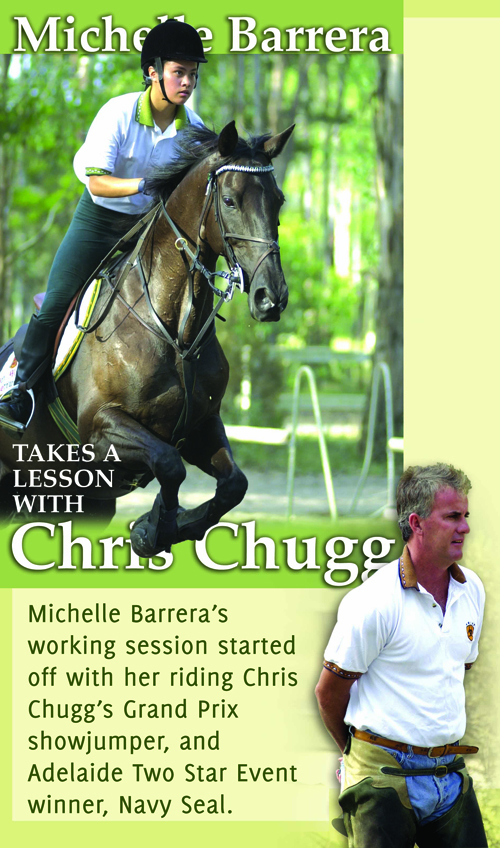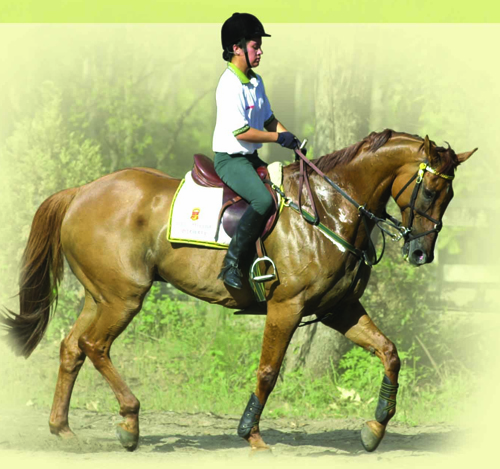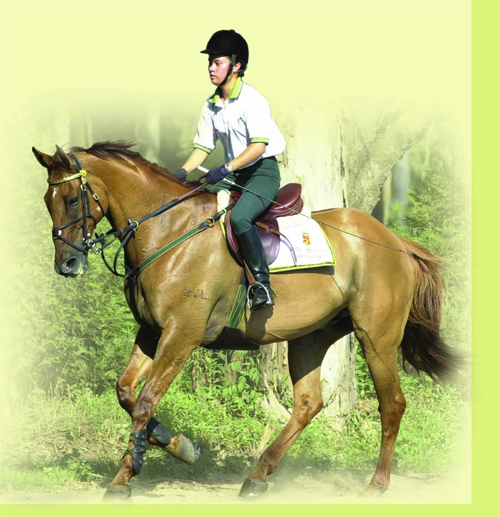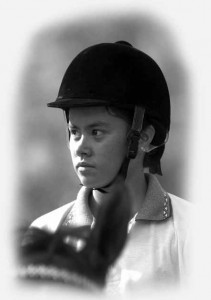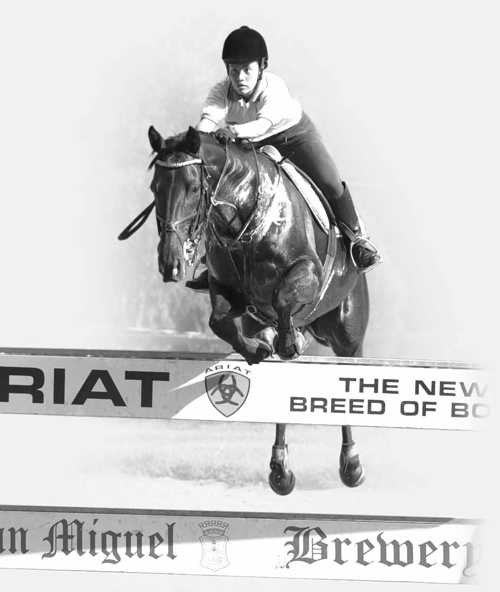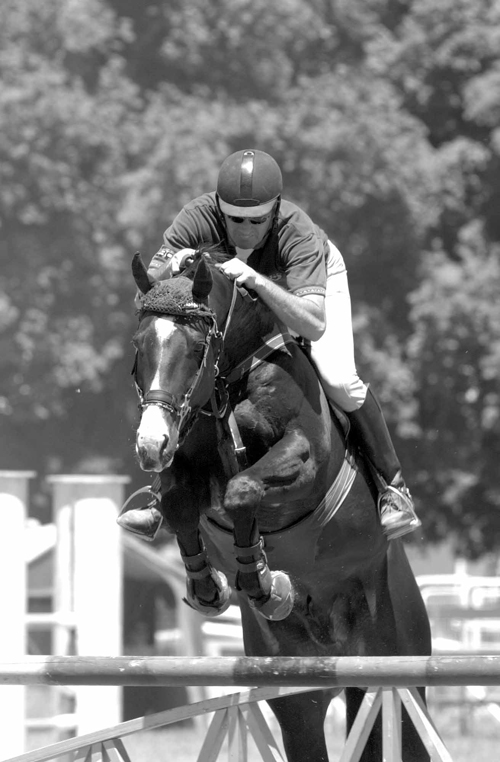He’s a typical big, hot, Thoroughbred, and Michelle is certainly not going to keep him under control with force, but she looks at home on the big black horse, on which she has already competed. And it’s easy to see why once the lesson gets underway, because, surprise, surprise, it’s how every good working session starts, whatever the discipline, with ‘the basics’.
Forward and Straight
“Keep the horse straight, let’s go up the gears – 400 (Strong canter with longer than 12 foot stride) – come back to a trot, that’s right”.
“The most important thing is keeping the horse’s neck straight and keeping the horse on your outside rein and try to get him to stretch down through the neck so we relax him a bit more through the back right from the start”.
Now a couple of fences to test how our basics hold..
“We are going to do a couple of figure eights and circles over the lower fences, a couple of verticals and a double, turn right jump the plank fence, no drift”.
Soft, Round and in Self Carriage
And, surprise again, it’s not only dressage riders who worry about outline these days – although in truth, Chris Chugg was always one jumping rider who paid great attention to his flatwork, and his pupils are expected to do the same:
“The horse looks better, he looks nice and more relaxed in his frame, he is not so tight in his gullet. Remember to get the back end soft and then you’ve got to get the front end soft. Make sure the horse is active enough behind, ride forward into a natural frame, soft hands. When you turned you lost his neck, ride it more forward. Every time you make a turn you slow your rhythm down 40% and the horse doesn’t stay soft in your hand. To maintain a rhythm you have to keep a leg on, Michelle”.
“Put the neck down, you are doing nothing when you are riding him with his neck up”
Another test over a fence …
“Now let’s ride five short strides to the gate, then track left. Maintain a rhythm, let him come back. Grow taller and lighter. Come back to the bounce again, let’s have a conversation with the horse here, rather than a hand that just grabs the last two strides. Now get the horse to stretch his neck a little bit in front of the fence, the first thing that works when a horse leaves the ground is his neck and wither”.
“We want eye contact, too short a turn! Look up, keep the horse on your outside rein on the turn. Slower canter standing with quarters under, more legs than hand, allow the canter to relax. You’ll feel the horse give you a softer ride underneath you once he is relaxed.”
“Careful when you change direction, Navy Seal likes short cuts. That’s an animal, an animal will always take a short cut if it can. You’ve got to remember that while you are riding where you are looking, your horse will occasionally take you off track, that’s why it is always very important to have 90% leg on the horse, and 10% hand. They can’t argue with your leg, they can only argue with your hand. If a horse is accepting your leg through a turn, if he is accepting your leg to a fence, then he is going to continue to accept the leg. The most important thing is that he accepts the lower leg on him, and the balance in your hand comes from your leg.”
“Riding horses that are big and strong like Navy Seal or Ego, Michelle always has to make sure she has total control in a self carriage way, that the horse is not fighting her because she probably only weighs sixty kilos. It is very important for her to realise that you don’t need strength to ride. You can ride with a good feel, and good balance, which she has got. I try to make sure that she maintains softness in her elbows and that she understands that self-carriage is what she is really trying to achieve. Soft hands and a relaxed neck”.
“The first thing you learn when you ride a horse is to allow him to be himself a little bit – allow. Self-carriage and allow. Virtually no hands”.
Inside leg to outside rein
Once again Chris Chugg uses one of the key concepts of dressage in his jumping instruction – the relationship between inside leg and outside hand:
“The most important aid when you are going to turn is inside leg to outside rein, then carry your inside rein.”
”When you come to the jump, let him relax. When you went away from the jump, I didn’t hear your voice talking to him. Thoroughbreds are very reactive to noise and movement. You know he reacts to things around the arena that move, so it is very important that he is in a compliant relaxed mode. He reacts to things that you probably don’t see, or you won’t hear. Microphones, grandstands, anything.”
“I remember at Dapto where he freaked on the winning post of the dog track, he was a shocker, he would have won the class! He jumped so far away from the dog winning post that he hit the wing of the fence, nearly broke my toe, and left the fence up! Certain things petrify him.”
Straightness Specifically for Showjumpers
“Right hand turns are not allowed to bulge left over a fence, and left hand turns are not allowed to bulge right. If you ride a right turn, you must jump the fence right of centre, you are not allowed to jump it left of centre on a right turn. You must keep the horse’s shoulders straight. He is a little bit tense today because we haven’t jumped him since the weekend, and it was pretty nerve wracking for him then. His first World Cup in three years”.
“When I use the terms right of centre or left of centre, I should explain. I try to make sure that when the riders jump a fence, there are three points on the fence that the rider can jump. You’ve got the centre line, which leads you to the middle of the jump; you’ve got left of centre; and you’ve got right of centre. I teach my riders that when we are in a jump off, or even training at home, that when you turn right, you never use left of centre on a right hand turn. In other words the horse gets to the fence, and he is not bulging through his outside shoulder, you are turning right, he is not bulging left, you finish the line where you started, the horse stays straight.”
“If we have a right hand turn in a jump off, my horse generally knows that if I place him right of centre, and keep the weight in my left iron on take off, that he is going to turn left. It not only keeps the shoulders straight before the turn, but it also opens the jump up, I’ve got the whole angle of the fence to the left.”
“A lot of riders will make a turn and cut across the fence, and that is all very well but if you win two classes at a show, you won’t win two classes next week because you have taught your horse to dive across the fence. Even if I am trying to win a jump off I try to keep my basic rules happening. If I ask a rider to cut a corner, or show them a short line, or expect him or her to up the tempo and win the class, I give them instructions: right of centre, left of centre, turn up. So there is an ideal way of meeting every fence and then the horse goes away in a relaxed way even though he is in a jump off. That means that the horse can be consistent – and I make sure that Michelle understands that you’ve got to win today, but you also have to be able to win tomorrow.”
“Square the shoulders up against the fence, so the horse’s back end and front end are in a straight line. When you don’t prepare the shoulders to follow in a straight line, the shoulders go one way and the hindquarters go the other way, and that is screwing – that is the worst thing in the world, because we never want a horse that slips across the top rail. When you have to ride a fence on a curve, straighten the curve up. Taking off right of centre and landing left of centre is a no, no, because it teaches a horse to drift.”
Navy Seal was sent off for a well-earned hose down, and Michelle started work on her own World Cup horse, Will.
Forward first …
“Ride him forward and make him balance himself up, you haven’t got anywhere yet! When he is holding himself back off your leg, it means that he is holding himself back in his back and neck. That’s right, now you are doing less with your hand and more with your leg. Ninety percent leg, ten percent hand. Work him long and low, work the jaw not the neck”.
And in relation to a line …
“I said four strides, and he did it in five. What’s he going to do when he gets to the show at the weekend with all the cattle and the rides, and you are wondering why his jaw is getting stiffer, it is because he is not going forward.”
Self carriage …
Once again, Chris was not just wanting his pupil to get over the jumps but to travel between the jumps, in style:
“Get him back up in front. Too much inside rein Michelle, bring him up off the forehand now – he’ll grow taller and you’ll grow taller. Slow it down, circle right and ride the inside hind leg. Yes, make him carry himself, don’t separate your hands so much, ride the inside hind and bring him back to trot”.
Transitions …
“Let him walk a little, take a change of direction, change the diagonal, change the diagonal again – it gives you something extra to do, lengthen the neck while at the same time, you change the diagonal. Soften your inside rein, have the horse accepting your inside leg into your outside rein. Inside leg, and opening rein – your rein does not pull back, never pull back with either rein. A sideways half halt is always better than a backward pulling half halt. Go large, and remember when we go large, we drop our weight in the direction we want the horse to go larger. Take a little more weight on your stirrup iron.
In the canter Chris starts Michelle on some real stretching exercises, with a serpentine of looping counter canter.
“Take your left seat bone and take it towards the right hand side of the saddle. Sit in the direction that you want the horse to travel, go large, forward again…”
We never get away from rhythm …
“A jumping horse has to learn to turn in the rhythm you are riding , in your corners, on your circles, ride the inside hind leg. Ride the shoulder fore, put his front legs more on the inside track. Now circle again, and into the shoulder in – a little more rhythm, allow, allow with the elbows, soft through the neck.”
Some lateral work …
These jumping horses don’t just have to go forwards, they have to learn to go sideways:
“In the bottom corner, twenty metres circle, outside rein half halts, ride taller, now let’s try to enlarge the inside hind on the circle, your inside leg should try to put the horse’s inside hind on a two track position from the inside front leg. Make him work the inside leg, make him carry the weight behind. Go large, a little shoulder fore down the long side. Careful, you’ve got your weight to the outside, get your weight to the inside.”
“Now try a little half pass right. Sit right, bend right, open your rein to the right, allow, allow, and open your rein in front of your hip, not behind your hip. No, he mustn’t just curl up and go nowhere.”
“Now ride some quarters in on a straight line, now a little shoulder in before the turn, and canter on.”
“Okay now go long and low, let him stretch, that means his nose goes forward Michelle, he doesn’t tuck it in. Longer reins.”
And changes …
“Straight line down the long side, and look for a flying change. Transfer your weight to the right, now transfer your weight to the left. Relax. You’ve got your whip flying around. You did one flying change and your reins got long, that interferes with your next flying change. When you have twelve fences on the course, the changes have to come smoothly, change your weight before you give him the aid. Take the counter canter until you are ready to change. Talk to the horse, use voice communication, and carry your hands down.”
And how it all applies to show day…
“What I hate to see in a jumpoff is if the horse does a flying change it jumps in the direction of the new lead, they don’t travel in a straight line. It’s important to be able to jump off against the clock, without untraining a horse. Michelle is a good enough rider now that she can jump a clear round, but I want to see the jumpoff as basically an extension of that first round. Jumpoffs are at 400 to 450 metres a minute, whereas first rounds are up to 350 to 375. I train Michelle at 250, which is basically a working canter, 300 which is a little bit above a working canter, 350 is a medium canter but with self carriage – so that the horse learns to take a 12 foot stride when he is cantering. Then we go into 400, 450, 500 in a jumpoff.”
“Michelle has a rhythm to every fence when she goes out on course, and she has a rhythm for the jumpoff. I expect her to be able to go through the start flags and get to the finish without changing that rhythm. She might lose a class doing that – great – the most important thing is that she can ride at 450 a minute, because internationally that’s what she is going to have to do. I just use the terms 250, 300, 400 and so on, so my students know what it means. A lot of riders get to a show and say ‘what does it mean?’ Well the course is measured at 350 and you have to understand that 350 a minute actually produces a 12 foot stride, and then when they are travelling at 400 metres a minute, the horse is producing a stride that is a little larger, so the horse naturally feels a little bigger, a little more powerful. I ask my students to practice up to 500 metres per minute, so that when they get into the ring, the horse is actually very relaxed, he has been trained in jumpoff speed so when I say ‘jumpoff’ I mean that the horse is still being trained. I still ask Michelle to train a horse even when she is trying to win a class. That’s very important, otherwise the kids just learn to go fast.”
“I see a lot of young riders and juniors who because of the level of training they have had, they have never been taught with the idea of having a horse that is going to go Grand Prix in two years time. A lot of riders go out there and they are really ‘untraining’ every time they start. Michelle understands that she needs to train for the bigger picture.”
“The most important thing is that when you take a horse into the ring, he goes in confident and relaxed, and he finishes his competition in the same mode, whether he has won the class, or whether you have gone for a training run. It is very important that the horse comes out of the ring still being educated, he should be travelling into a nice contact, he’s still got self carriage, he hasn’t cheated two or three lines to a fence, he hasn’t jumped from right to left, he hasn’t screwed his shoulders around in the jumpoff. If Michelle goes out and rides a jumpoff round that untrains the horse, we go back and watch the videos, and say this could be done better, this could be done smoother – sure, you did a really good job cutting the corner, you cheated the corner and you got away with it but you had the next fence down. There is always a sacrifice to be made for bad riding and nine out of ten times it is four faults or eight faults.”
“Michelle is not a ribbon hungry person but she has got the understanding the horse is being trained for the bigger picture. Will is her first Grand Prix horse, and she is hoping to ride in a World Cup, next weekend (she did, and placed 9th at her first attempt at a World Cup!), and then do the whole World Cup circuit next year, and maybe he’ll be her first Grand Prix horse to take to Europe.”
“Michelle is always training. She rides here five times a week, and even at the shows in warming up and training, I always keep an eye on her. I’m a hard worker but I expect her to put more time into it than I do. In the long term she is going to have a horsemanship, and a ringcraft with horses that not many riders have. There are no young riders who I have seen come through the ranks in the past ten years, who have had this sort of steady progression from juniors to young riders to Grand Prix. They normally do it in two or three years and it is a bit of a rushed job. Most riders don’t have horses which are suitable to go through the grades, but Michelle does, she has horses that can do metre thirty, metre fifty classes – she should take advantage of it, and she does.”
“She is probably the best student I have had, she pays attention, she can pick up things and do it at the canter. A lot of showjumping is taught at the canter, I don’t stop and start my lessons a lot. I like the riders to give the horse a relaxing time, so the horse has a breather but I find a lot of the problems happen while the horse is cantering to the fence, so I do a lot of my teaching while the horse is cantering, and a lot of students can’t handle that, they can’t listen and work at the same time. Unfortunately, in competition you have to know how to do that, because horses react differently most times at competition – except for Navy Seal, he is just as hard to ride at home as he is at a show, but he also steps up two gears and becomes a V12 when he goes to a show.”
“This horse, Will, sometimes when he gets into a jumpoff, then he loses self-carriage, so I am trying to teach Michelle to ride the horse through a turn so he arrives at the fence with good self-carriage and his hocks under him. She would like to creep back to a slower gear, she would like to creep back to 250 to make her turn but if she does that, she doesn’t get the distance she needs.”
“Michelle is seventeen now, and she has come off a lot of good junior horses, now she has to learn what a larger horse feels like, to have stride and power underneath you. It is very scary to get on a horse like Navy Seal where every inch is an active muscle – muscle that can work against you, or work for you. I’ve had him for a long time, so I know his quirks, and you have to think three steps ahead of him all the time. You’ve got to be thinking three fences ahead, two fences ahead. He’s a typical Thoroughbred, but he is probably the hottest Thoroughbred, and the strongest Thoroughbred, and he won’t back up – Michelle has been used to riding horses that will look after her and back up – whereas Navy Seal has to be presented to a fence in the right rhythm and the right sequence of strides because he knows no better. He is not the sort of horse that if you half miss your distance to a fence, he will not slow down to jump it.”
“It is important for Michelle to learn that there are some horses on the borderline of being hot but still being able to jump clean, she needs to be able to manage that. Now her eye is working better, I am teaching her to maintain her rhythm. If she maintains her rhythm she can always find a good distance on Navy Seal. She also rides Ego, she also rides Skyhigh II in her jumping lessons. The idea is that Michelle learns to be able to ride every horse in the team. Hopefully I’ll be getting some new horses to ride myself, and she’ll be able to ride my older horses in the World Cup classes. That’s the whole idea. She has to learn to ride every style of horse. I’ve got three Grand Prix horses and they are all very different.”
“Michelle has to learn to be that style of rider because that is what the world is about, when you are buying and selling horses, she has to be able to understand horses – there are no gimmicks. Horses still have to be horses. They’ve still got to be relaxed animals. At the end of the day, the largest market will be for the amateur rider and the amateur rider needs a nice horse that can think for itself.”
“It’s funny because she is a lot stiller and doesn’t carry as much weight as me over a fence, I notice a lot of the horses react totally differently with her. Even if they are only relaxed in their flying change, or the corner before the fence, they are more relaxed – and that gives me an insight into what I am not doing, and where I can improve my position. I actually find the horses go better for her, and go better at home for her, than they go for me at home. It’s interesting. Ego is very much a Thoroughbred, and Skyhigh II is very much a German horse, and Navy Seal is very much a Thoroughbred. You can’t take advantage of horses on the flat, and you can’t over complicate things in their minds”.
“Michelle is preparing for 2004, for the next Olympics, that is the aim. Her family is prepared to back her, my job is to make sure that Michelle is a very seasoned rider by the time she is twenty, then she will start touring the world. I’m sure what she will be riding in Europe, will be a lot easier than those she is riding here because the quality of horse over there is so much better. If Michelle gets to the next Olympics that’s great, but the most important thing is that if she gets there, she is ready. It’s amazing how quickly she has come on. She has already ridden in her first Grand Prix – placed ninth in her first World Cup riding Will, and Will is not an easy horse to ride, so she has done a very good job….”

